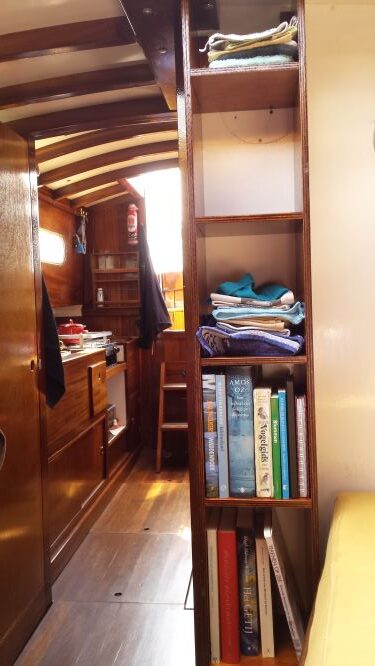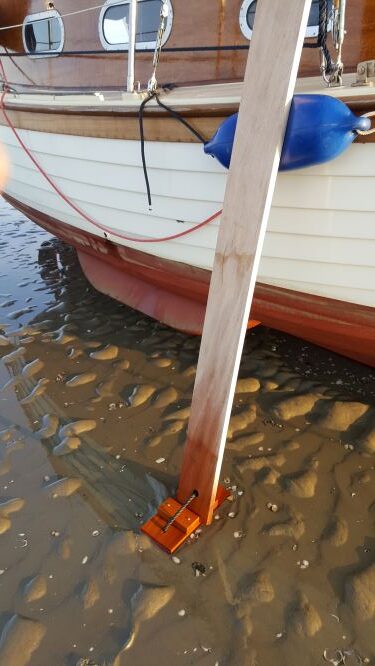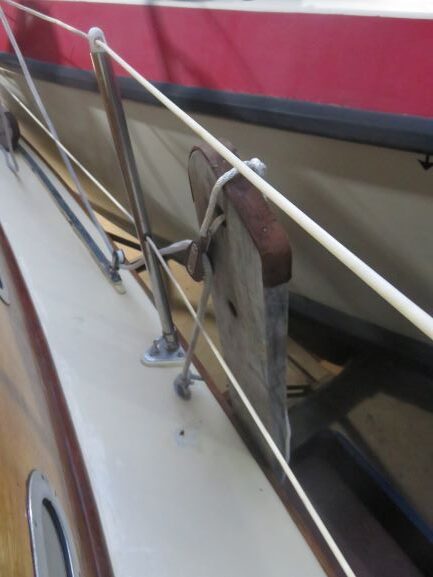
Bookcase, next to the port bunk, standing against the heads compartment
The underwater hull of the Finesse shows a collection of parts that are important for things like stability, tracking and- last but not least- comfort. Much has been written about the long keel, bilge stubs and the deep bilge keels, whether or not in combination with a center plate. (See the recent article Bilge keels and the loss of Liberty by Dave May, with commentary by Nick Ardley.
I would like to make a modest contribution to all of this, which is about my search for a comfortable way to fall dry with Josie, a Finesse 24.
The appreciation for Alan Platt as designer and builder of the Finesse boats cannot easily be overestimated. He designed fantastic ships that are ideally suited to the tidal area around the Thames and the East coast of England. Across the North Sea , where Josie’s home port is located, lies a similar area- the Wadden Sea. This is a large territory, stretching for about 500 km from Den Helder (The Netherlands) via Germany to Esbjerg (Denmark) . The Wadden Sea is separated from the North Sea by a large number of beautiful islands. In addition, several rivers flow into the Wadden Sea, such as the Ems, the Weser , the Elbe and the Eider. As a result of stormtides over the centuries , large inlets have been created in several places in the country, which are part of the Wadden area. The Dollard at the German-Dutch border and the Jadebusen in Germany are well-known examples. The Lauwerszee was also such an inlet until 1969, in which year it was closed off from the Wadden Sea by a long dam to create the sweet Lauwersmeer. This was where, in 2019, the Gaff (Lady Christina) versus Bermudan (Josie ) racetook place, which was reported on the Finesse website in an article dated 23 August 2020.
The Wadden Sea is a tidal sea, with tidal differences ranging from 1.50 metres in the west and in the far north, to more than three metres in the German part. The enigmatic character of the Wadden Sea was described over 100 years ago by Erskine Childers in his famous book, The Riddle of the Sands. That the east coast of England is not inferior to this has been sufficiently demonstrated by people like Maurice Griffiths (The magic of the |Swatchways ) and the well-known Nick Ardley. To my shame, I have to admit that I haven’t read Nick’s books yet, but his comments on Facebook, which no-one sailing along the east coast should miss, make me look forward to it with increasing eagerness.
To round off this hymn of praise to writers who matter to us, I mention, without any tendency to chauvinism, the Dutchman Hans Vandersmissen, who in an entertaining but instructive way wrote Rond de Friese Zee (unfortunately incomprehensible, since not translated into English) reporting on several trips in the 70s/80s last century from the Netherlands to England and back again. He was rowing (single-handed) and sailing in his Drascombe Longboat The Pride of the Fleet.
It should therefore come as no surprise that as a Finesse sailor in tidal area as such as the English east coast and the Wadden Sea you cannot board without a large bookcase. The designer of the Finesses did not really provide for this, but fortunately Dave and Mary May came up with something in the form of a beautiful bookcase in the forecabin of their Lady Christina. In the meantime I took the liberty of enriching Josie with a bookcase according to their design.
Anyway, we were going to talk about drying out comfortably.

Sand-leg in position. Note the foot to spread the load, and the fender to prevent damage.
I wouldn’t want to miss the long keel under the Finesse. But only an tightrope artist could stand it on end. As soon as the water falls, the boat tips over into a position that can get in the way of reading a book or enjoying good night’s rest. Much has been thought through and written about this problem and I derive an important part of my knowledge from a series of articles from the Berichten van de Vereniging Wadvaarders, supplemented with some personal experiences. This association (Vereniging Wadvaarders) stands for free and responsible sailing on the Wadden Sea, good seamanship, in balance with nature and without unnecessary restrictions. Sounds good!
We are fortunate that the bilge keels or bilge stubs prevent the boat for falling completely flat. But it is still flat enough to yearn for some more upright position. In order to achieve this, the so called wadpoten/sand-legs can do good service. These sand-legs consist of two planks (e.g. bankirai), which can also serve as buffers when mooring against piles.
And you can use them as a crutch for the lowered mast, as a gangway and to lay across the cockpit edges as a raised seat. For the latter, other solutions are also known, such as a

Booster box
small box, which you can place on the cockpit benches as a booster. I made such a box from iroko and for that reason it is heavy enough to stand on a considerable slope. Just to be sure, you can fix it with a rope. In fact it is a mobile booster. When you want to tack, take the box with you to the high side.
To prevent the sand-legs from sinking into the mud, they stand on two ground-boards, which are tied to the legs with a small rope.

Simple arrangement using a chainplate (U bolt) and the jib car which locates the leg and takes the up-thrust from the ground.
The sand-legs stand on either side of the boat and to protect the varnish you can hang a fender between the leg and the boat. The legs are attached to the boat by a line connected to the chain plates where the shroud is connected to the deck. From there the line goes up to a small block that is attached to the top of the leg and then goes down through the jib car and from there it is fixed on the jib-sheet winch by the cockpit. My sand-legs are 200 cm long, 15 cm wide and 3 cm thick. The tip is angled and covered with leather and comes on deck where the legs as a crutch.
Josie stands like a house thanks to the sand legs on the  dried-out strand near the eastern tip of Schiermonnikoog. A beacon of peace. But it is done with that peace when the tide is coming on and the boat is afloat again. Than the sand-legs lose their grip on the ground and they float rapidly to their line next to the boat. The legs have to be adjusted again with every change of tide. And that is at the expense of the desired carefree rest.
dried-out strand near the eastern tip of Schiermonnikoog. A beacon of peace. But it is done with that peace when the tide is coming on and the boat is afloat again. Than the sand-legs lose their grip on the ground and they float rapidly to their line next to the boat. The legs have to be adjusted again with every change of tide. And that is at the expense of the desired carefree rest.
To maintain that rest, I turned to wadpijpen/sand-pipes instead of sand-legs. These pipes are transversely placed under the bilge stubs, so that the boat stands on the keel without falling. That is easier said than done!
The difference in height between the bottom of the long keel and the bottom of the bilge stubs is connected to the Finesse 24 about 30 cm. So you only need a pipe with a diameter of 30 cm. By the way, that is quite a colossus, but miraculously I managed to store two of

Sand pipes, chained together to be passed under the bilge stubs.
those pipes under the port berth in the forecabin. I saw sandpipes with a diameter of 20 cm on a Cornish Crabber, the height difference being somewhat smaller. These can probably therefore be sufficient- the boat stands not quite right, but enough to live with.
The sandpipes are made of polyethylene and are 50 cm long.
They are connected together by a chain that keeps them in the correct position under the bilge stubs.
I have not yet succeeded, but practice makes it possible. It is difficult to bring the pipes into the right position when the boat still floats, probably the fault of the chain that connects both pipes. Experiments will continue next year.

Sand pipes in position
What I have learned, meanwhile, is that the gain in comfort that an upright ship provides barely outweighs the effort it takes to situate the sand-legs and sand-pipes in the right position and to keep them there.
It is nice to be busy with this kind of things, but just dropping askew is also quite peaceful.
Pieter Schulting
Josie , Finesse 24 No. 63



Excellent article Pieter. Josie is looking good too…
We don’t sit in sand as a rule. In mud Whimbrel sits upright.
Very interesting article there doesn’t seem to be an easy answer to the need to keep a Finesse upright on a sandy shore. When I owned Pippet I actually slide off the coach roof and into the water as she heeled over onto her stubby bilge keels
Now Liberty with her long steel bilge keels ha shown me how vulnerable the hulls are to being badly damaged if the boat is subjected to passing vessels wash at the same time as the Finesse is coming afloat. I think legs are the answer but they are awkward and again if a big swell develops the twisting action could damage ones hull
. As Nick Arley says these boats were meant for mud berths really or kept permanently afloat. When I was taken out for a demo sail by Allen Platt in the late 1970s he said a permanent afloat mooring was the best for the boats. I must agree the constant pounding a boat gets on a sandy river bed on drying out moorings must give rise to hull fastenings being strained at the very least.